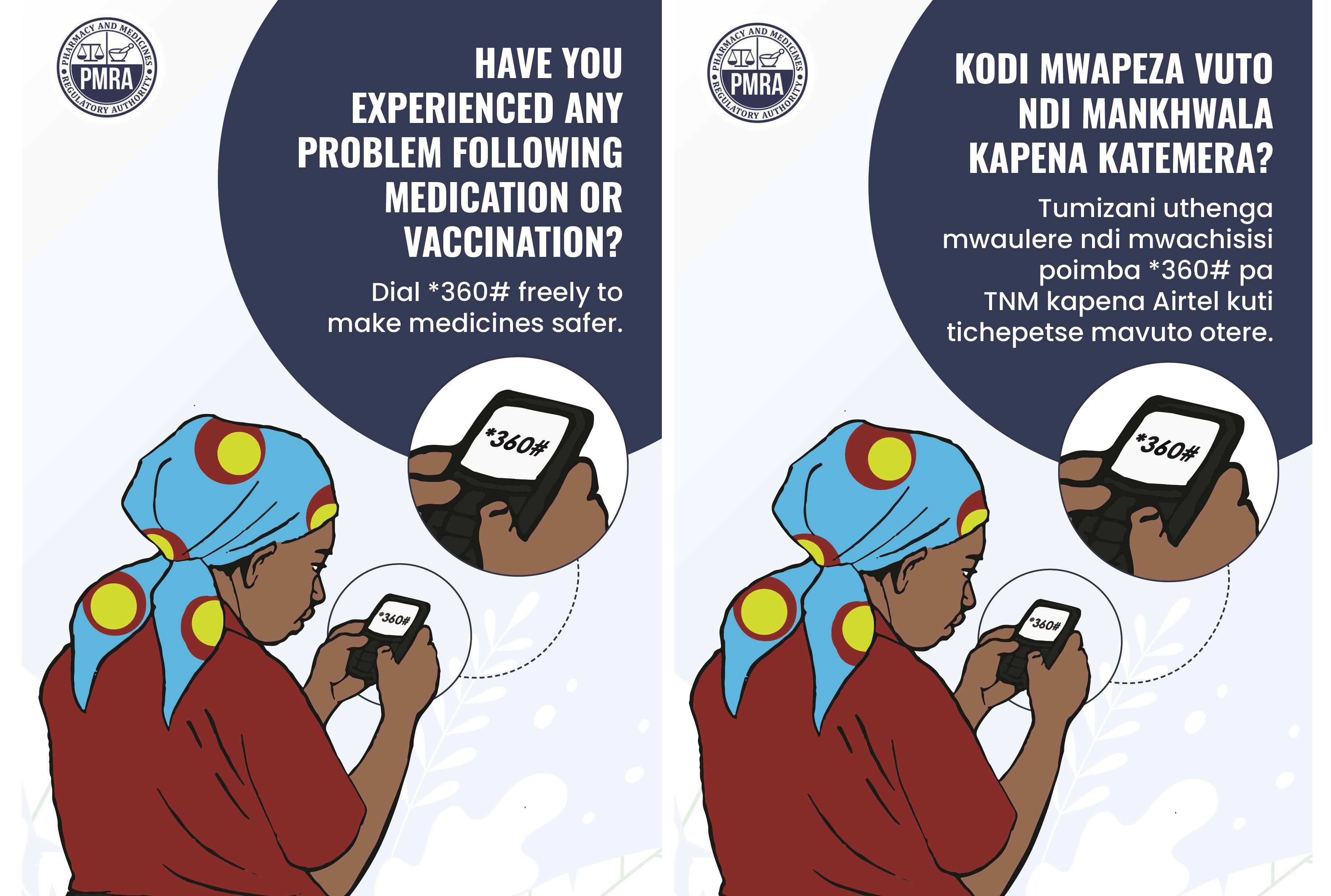TDR, as part of the Access and Delivery Partnership (ADP), is supporting the Pharmacy and Medicines Regulatory Authority of Malawi for the introduction of innovative techniques to enhance reporting of adverse drug reactions and adverse events following immunization.
Challenge
Collecting spontaneous reports of suspected adverse drug reactions (ADR) remains the core activity of national pharmacovigilance centres. However, under-reporting is a persistent problem in Malawi: the traditional method of using paper forms causes delays and does not allow patients to directly report side effects themselves.
Initiative
In 2020, the newly created National Pharmacovigilance Centre (NPC) of the Pharmacy and Medicines Regulatory Authority (PMRA) of Malawi conducted a variety of activities aimed at institutionalizing pharmacovigilance activities in public health programmes and in hospitals, as well as building capacity of health care providers in reporting adverse drug events.
First, a nationwide media campaign on national radio and TV stations was organized in late 2020 to raise awareness of the general population and enhance reporting of suspected adverse drug reactions. This MedSafety Week Social Media Campaign was linked to the international campaign led each year by Uppsala Monitoring Centre (UMC), a WHO Collaborating Centre.
Second, an extensive cascade training programme targeting district-level pharmacovigilance focal points was implemented. These focal points in turn trained health care workers from a variety of health facilities on adverse drug event detection, management and reporting.
Third, to measure the impact of the training programme, a Knowledge, Attitude and Practice (KAP) survey involving a mix of quantitative and qualitative methods took place from June to September 2021 in two districts of each of the northern, central, southern and eastern regions of Malawi. This survey was conducted by the Kamuzu University of Health Sciences of Malawi. As part of the survey, a sample of health care workers trained in pharmacovigilance were administered a questionnaire to assess their Knowledge, Attitude and Practice related to pharmacovigilance. Face-to-face interviews were conducted to assess the feasibility and preferences of adverse drug reaction (ADR) reporting tools among health care workers. Furthermore, ADR reporting data was extracted from the national database to measure the ADR reporting rates after the training.
 Fourth, in 2021, the PMRA developed a USSD (Unstructured Supplementary Service Data) platform for reporting ADR and adverse events following immunization (AEFI). This novel tool, called Medsafe-360, will be introduced in early 2022 after a promotional campaign. This mobile-based SMS platform allows for direct reporting of suspected adverse events by patients and health care workers. This new technology is expected to reduce delays in reporting as it is quicker than the paper form. In addition, the USSD application does not require a smartphone nor an internet connection. A promotional campaign is at the preparation stage. To assess its effectiveness, the facilitators, the obstacles of the promotional campaign and the tool itself, a pilot project in HIV clinics of three districts is being implemented before full nationwide extension of the USSD tool.
Fourth, in 2021, the PMRA developed a USSD (Unstructured Supplementary Service Data) platform for reporting ADR and adverse events following immunization (AEFI). This novel tool, called Medsafe-360, will be introduced in early 2022 after a promotional campaign. This mobile-based SMS platform allows for direct reporting of suspected adverse events by patients and health care workers. This new technology is expected to reduce delays in reporting as it is quicker than the paper form. In addition, the USSD application does not require a smartphone nor an internet connection. A promotional campaign is at the preparation stage. To assess its effectiveness, the facilitators, the obstacles of the promotional campaign and the tool itself, a pilot project in HIV clinics of three districts is being implemented before full nationwide extension of the USSD tool.
Results
The national public awareness campaign on drug safety took place from 2 to 8 November 2020, with 140 radio and 56 TV jingles broadcast on local radio and television stations, and press releases published on the theme “every report counts.” Patients and health care professionals were called upon to report suspected side effects from medicines immediately.
The cascade training programme decentralized safety monitoring by increasing the coverage of adverse event detection and reporting: 52 district health workers from 26 districts were trained as trainers who in turn trained a total of 391 health care workers. A total of 57 retail pharmacists in Lilongwe, Mzuzu, and Blantyre were trained as well. Five public health programmes (tuberculosis, neglected tropical diseases, Expanded Programme on Immunization, reproductive health and Health Technical Support Service Directorate) also attended training on pharmacovigilance.
Results from the Knowledge, Attitude and Practice (KAP) survey showed a very significant increase in pharmacovigilance knowledge from a mean score of 56% (95% CI 53% to 58%) to 66% (95% CI 64% to 69%) after the training with a p value of less than 0.001 at 95% confidence interval. There was also an increase in the rate of ADR detection by 2.8-fold and an increase by 1.8-fold of the ADR reporting rate. The number of reports also increased significantly from 15 to 297 six months after the training. The qualitative analysis found that though participants prefer the paper-based reporting tool, they have challenges with the system such as lack of reporting forms, delay in transferring reports and lack of feedback. The overall findings of this study will be discussed in an upcoming national workshop and will help in developing informed decisions and measures to improve medicine safety in Malawi.
As part of the pilot programme, PLHIV in Malawi will soon be able to report a suspected adverse drug reaction through the USSD platform (named MedSafe360) by dialing a code number (*360#). This is free of charge for the user. Promotion of this tool will currently be implemented. In 2022, TDR will support the evaluation of the pilot implementation of the MedSafe-360 tool led by the Pharmacy and Medicines Regulatory Authority and the Department of HIV and AIDS of Malawi.
For more information, please contact Dr Corinne Merle.




